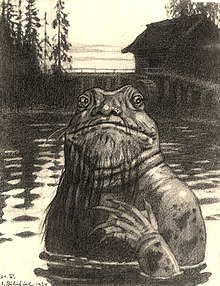Vodyanoy
This article includes a list of references, related reading, or external links, but its sources remain unclear because it lacks inline citations. (March 2009) |

In Slavic mythology and Norse mythology, vodyanoy (‹See Tfd›Russian: водяно́й, literally "watery"), vodyanoi, Belarusian vadzianik (Belarusian: вадзянік), Ukrainian vodianyk (Ukrainian: водяник), Polish wodnik, Czech and Slovak vodník, Bulgarian and Macedonian vodnik (Bulgarian: водник), Slovene povodni mož or Serbian vodenjak (Cyrillic: водењак) and Norwegian havmannen is a male water spirit. Vodník (or in Germanized form hastrman) in Czech fairy tales is the same creature as the Wassermann or nix of German fairy tales. In many such languages the word is also used to mean the Aquarius zodiac sign.
Vodyanoy
Vodyanoy is said to appear as a naked old man with a greenish beard and long hair, with his body covered in algae and muck, usually covered in black fish scales. He has webbed paws instead of hands, a fish's tail, eyes that burn like red-hot coals. He usually rides along his river on a half-sunk log, making loud splashes. Consequently, he is often dubbed "grandfather" or "forefather" by the local people. Local drownings are said to be the work of the vodyanoy (or rusalkas).
When angered, the vodyanoy breaks dams, washes down water mills, and drowns people and animals. (Consequently, fishermen, millers, and also bee-keepers make sacrifices to appease him.) He would drag down people to his underwater dwelling to serve him as slaves.
Vodník

In Czech and Slovak folklore the features of the vodník are markedly different to the East-Slavic conception; he has a completely human constitution and habits, except for few differences – vodníci (plural of vodník) have gills, webbed membrane between their fingers and their skin is algae-green in colour (as well as their hair, which is typically of pale green tone). Their overall dress and appearance is weird, sometimes even resembling a vagrant; patchy shirts and (by modern standards) odd hats - often boaters with long speckled ribbons - are commonplace. They can withstand lingering for hours outside their ponds. When they do so, one can tell them unequivocally by their wet coat-tails from which water is dripping under all circumstances. The vodník's face is usually unshaven and it is not uncommon for a vodník to have a large, wet, tangled beard.
Czech and Slovak tales have both evil and good vodníci (relative to human beings) who do (or don't, respectively) try to drown people when they happen to swim in their territory. Vodníci would store the souls of the drowned in porcelain lid-covered cups. They consider their cups as the most valuable heritage and display their "work", and number these cups they see as proportional to their wealth and/or status among other vodníci. When the lid of such a cup is removed, the soul within (in a form of a bubble) will escape and be liberated. Except for fish (or perhaps fish spirits), they do not have servants. Otherwise, vodníci spend their time by running their territory or – in their spare time – playing cards, smoking pipes or just sitting at the water surface (on rocks, willows nearby) and loitering. Fishermen ask the vodník for help by placing a pinch of tobacco in the water and saying, "Here's your tobacco, Lord Vodník, now give me a fish." In Czech and Slovak tales vodníci live in ponds or rivers; there is no mention of a particular dwelling and the 'half-sunken log' is unapparent. There are almost no references to vodníci with connection to sea water, but it is supposed that it would be dangerous, even deadly for them.
Cultural references

- Vodyanoy is one of the best known characters of the Soviet cartoons. In the Soviet animated film The Flying Ship, he performs a song about his loneliness and need to talk with someone.
- David Wiltshire's novel Child of Vodyanoi (adapted into the TV series The Nightmare Man) used the water spirit as a metaphor for a miniature Russian submarine.
- Composer Antonín Dvořák wrote a symphonic poem entitled Vodník about this creature, who is also a character in his opera Rusalka.
- In China Miéville's Bas-Lag novels, the Vodyanoi are an aquatic people skilled in water-based magic. In Miéville's Perdido Street Station, Vodyanoi dockworkers go on strike and use their magic to blockade a river shipping route.
- The Vodyanoi appears as a monster in the 1st Edition Dungeons & Dragons Fiend Folio, p. 93. It is described as a variety of Umber Hulk.
- The 1974 Czechoslovak comedy film about the end of vodníks in Bohemia, How to Drown Dr. Mracek, the Lawyer (Jak utopit dr. Mráčka aneb Konec vodníků v Čechách)
See also
References
- Rose, Carol (2001). Giants, Monsters, and Dragons. W. W. Norton & Company. p. 384. ISBN 978-0-393-32211-8.
{{cite book}}: Cite has empty unknown parameter:|coauthors=(help); More than one of|pages=and|page=specified (help)
